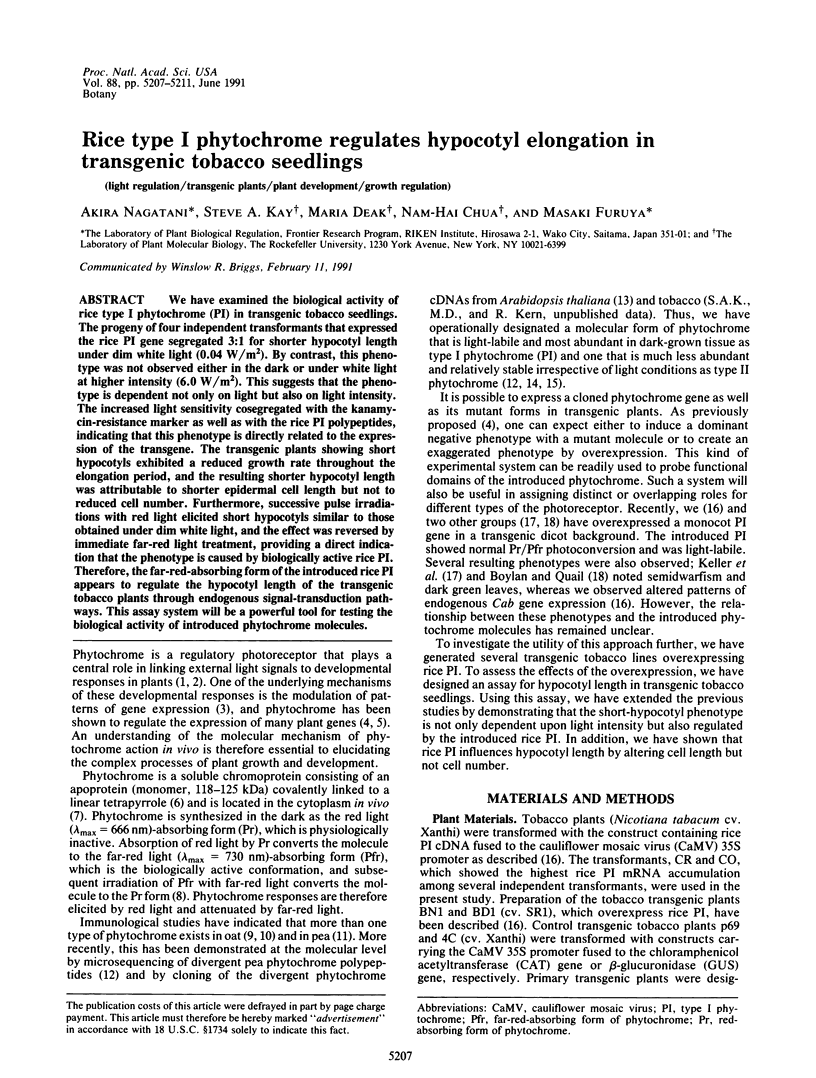Abstract
We have examined the biological activity of rice type I phytochrome (PI) in transgenic tobacco seedlings. The progeny of four independent transformants that expressed the rice PI gene segregated 3:1 for shorter hypocotyl length under dim white light (0.04 W/m2). By contrast, this phenotype was not observed either in the dark or under white light at higher intensity (6.0 W/m2). This suggests that the phenotype is dependent not only on light but also on light intensity. The increased light sensitivity cosegregated with the kanamycin-resistance marker as well as with the rice PI polypeptides, indicating that this phenotype is directly related to the expression of the transgene. The transgenic plants showing short hypocotyls exhibited a reduced growth rate throughout the elongation period, and the resulting shorter hypocotyl length was attributable to shorter epidermal cell length but not to reduced cell number. Furthermore, successive pulse irradiations with red light elicited short hypocotyls similar to those obtained under dim white light, and the effect was reversed by immediate far-red light treatment, providing a direct indication that the phenotype is caused by biologically active rice PI. Therefore, the far-red-absorbing form of the introduced rice PI appears to regulate the hypocotyl length of the transgenic tobacco plants through endogenous signal-transduction pathways. This assay system will be a powerful tool for testing the biological activity of introduced phytochrome molecules.
Full text
PDF




Images in this article
Selected References
These references are in PubMed. This may not be the complete list of references from this article.
- Benfey P. N., Chua N. H. Regulated genes in transgenic plants. Science. 1989 Apr 14;244(4901):174–181. doi: 10.1126/science.244.4901.174. [DOI] [PubMed] [Google Scholar]
- Boylan M. T., Quail P. H. Oat Phytochrome Is Biologically Active in Transgenic Tomatoes. Plant Cell. 1989 Aug;1(8):765–773. doi: 10.1105/tpc.1.8.765. [DOI] [PMC free article] [PubMed] [Google Scholar]
- Butler W. L., Norris K. H., Siegelman H. W., Hendricks S. B. DETECTION, ASSAY, AND PRELIMINARY PURIFICATION OF THE PIGMENT CONTROLLING PHOTORESPONSIVE DEVELOPMENT OF PLANTS. Proc Natl Acad Sci U S A. 1959 Dec;45(12):1703–1708. doi: 10.1073/pnas.45.12.1703. [DOI] [PMC free article] [PubMed] [Google Scholar]
- Coleman R. A., Pratt L. H. Electron microscopic localization of phytochrome in plants using an indirect antibody-labeling method. J Histochem Cytochem. 1974 Nov;22(11):1039–1047. doi: 10.1177/22.11.1039. [DOI] [PubMed] [Google Scholar]
- Furuya M. Molecular properties and biogenesis of phytochrome I and II. Adv Biophys. 1989;25:133–167. doi: 10.1016/0065-227x(89)90006-3. [DOI] [PubMed] [Google Scholar]
- Gilmartin P. M., Sarokin L., Memelink J., Chua N. H. Molecular light switches for plant genes. Plant Cell. 1990 May;2(5):369–378. doi: 10.1105/tpc.2.5.369. [DOI] [PMC free article] [PubMed] [Google Scholar]
- Kay S. A., Nagatani A., Keith B., Deak M., Furuya M., Chua N. H. Rice Phytochrome Is Biologically Active in Transgenic Tobacco. Plant Cell. 1989 Aug;1(8):775–782. doi: 10.1105/tpc.1.8.775. [DOI] [PMC free article] [PubMed] [Google Scholar]
- Keller J. M., Shanklin J., Vierstra R. D., Hershey H. P. Expression of a functional monocotyledonous phytochrome in transgenic tobacco. EMBO J. 1989 Apr;8(4):1005–1012. doi: 10.1002/j.1460-2075.1989.tb03467.x. [DOI] [PMC free article] [PubMed] [Google Scholar]
- Nagy F., Kay S. A., Chua N. H. Gene regulation by phytochrome. Trends Genet. 1988 Feb;4(2):37–42. doi: 10.1016/0168-9525(88)90064-9. [DOI] [PubMed] [Google Scholar]
- Sharrock R. A., Quail P. H. Novel phytochrome sequences in Arabidopsis thaliana: structure, evolution, and differential expression of a plant regulatory photoreceptor family. Genes Dev. 1989 Nov;3(11):1745–1757. doi: 10.1101/gad.3.11.1745. [DOI] [PubMed] [Google Scholar]
- Tomizawa K., Nayatani A., Furuya M. Phytochrome genes: studies using the tools of molecular biology and photomorphogenetic mutants. Photochem Photobiol. 1990 Jul;52(1):265–275. doi: 10.1111/j.1751-1097.1990.tb01784.x. [DOI] [PubMed] [Google Scholar]




